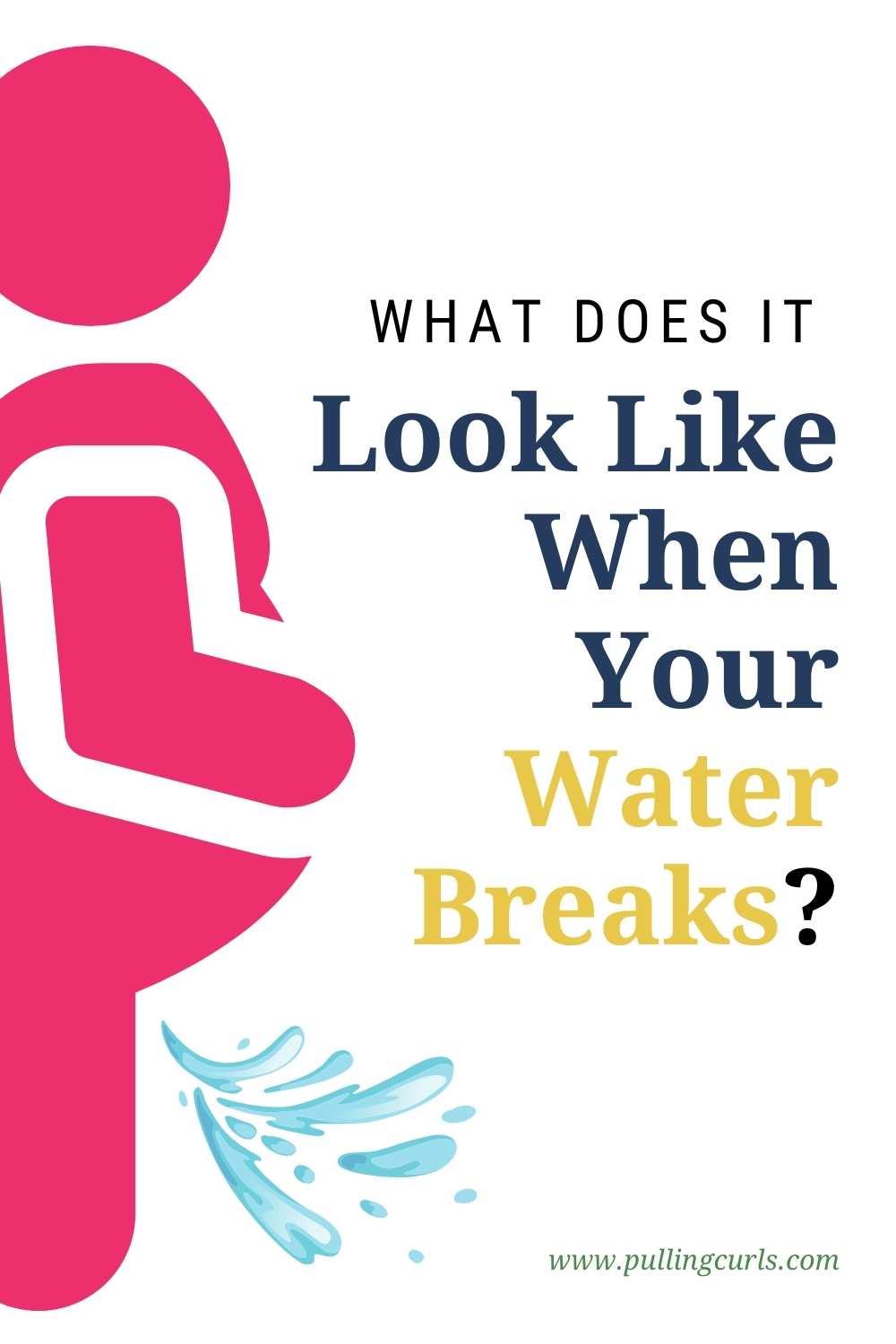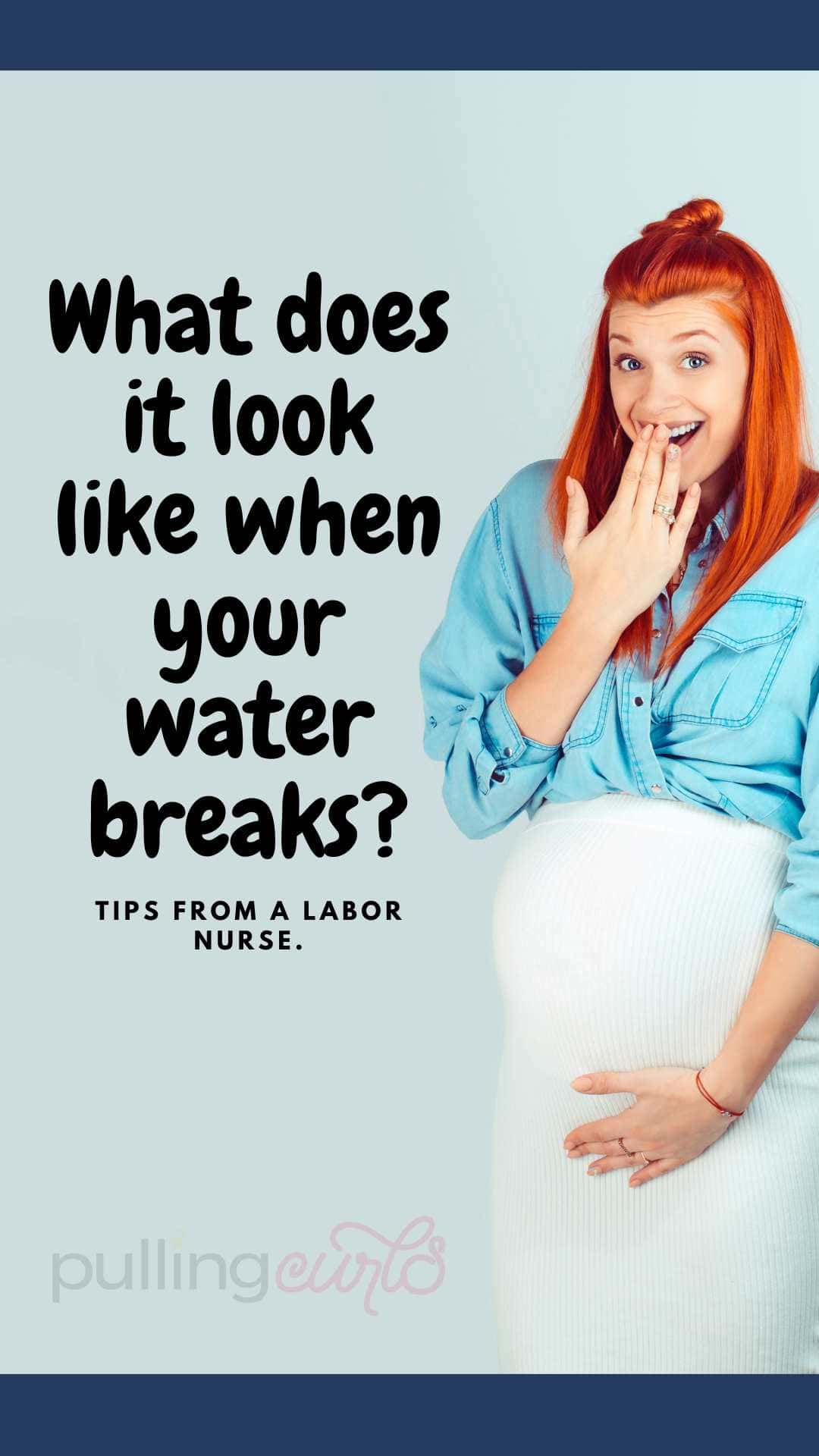Are you wondering what it’s going to look like when your water breaks? It’s SO normal because you’re probably worried about looking like you peed your pants. SO, what’s it look like and what can you to do prep for the “what if”?
Before we start freaking out on the “I peed my pants look” a reminder that only 10%’ish people’s water breaks outside of the hospital — so it’s really not THAT common, but common enough I think it’s smart to have a game plan.
Before we get going if you love “insider tips” like this (that people don’t normally talk about) — don’t miss my totally free insider tips series:
What is Amniotic Fluid?
You may not know what amniotic fluid is. Initially it’s made by the uterus/placenta to protect baby, but as you head into your third trimester the majority of it is made by baby’s pee.
Fun facts: Baby is “fed” by your blood but they take waste out of their blood stream and pee them out on their own. And that’s amniotic fluid.
Magical, right?
What water breaking looks like:
Good news: It’s initially (not normally) a ton of fluid.
I think we all expect a tub of water to come out of our nether regions when our water breaks — as that is how it looks in the movies, but it’s normally a small trickle and then it keeps coming.
Meaning, you likely have time to get to a toilet (because a LOT of people do think they’re randomly peeing their pants at first).
Quick reminder that “media” hasn’t done us any favors in helping us know what birth “looks like” — so I alwasy recommend getting prepared here. It’s so easy, you’ll be prepped before you know it!
It Keeps Coming out
The thing a lot of people don’t think about is that the fluid keeps coming out. Often in small gushes as baby moves or pees.
It REALLY grosses a lot of people out because it feels like they keep peeing and can’t stop themselves — so that’s something important to know.
Here’s a few other posts that might give you more information on gross things:
- 7 Gross Things About Childbirth
- What Does It Feel Like When Your Water Breaks?
- Orange Discharge When You Wipe During Pregnancy
- Did my Water Break or Is it Discharge (or pee)
- Losing your Mucus Plug — What does it mean?
It’s Normally Fairly Clear
Maybe you envision a big yellow spot from all the “baby pee” coming out — but normally it’s mostly clear. It is important to note a few things of the fluid you seeing coming out — I use the word TACO to remember them (and because, tacos):
- T – Time
- A – Amount (a lot or a little)
- C – Color
- O – Odor (does it smell bad?
Sometimes the fluid has some small streaks of blood (but shouldn’t be red-colored overall). It can also be brown-ish and all of that would be really important to call your provider about (or go straight to L&D/call 911 if it’s very bloody).
And while we’re here — don’t forget to grab your hospital packing list:
What to do after you think it has broken?
Ok, so you’ve gotten the picture of what it might look like. What do you DO when you think it’s broken?
First off, mentally check (or use a finger) to make sure nothing has fallen into your vagina along with the water breaking. Things could be like a hand, foot or umbilical cord. If you feel anything in there you need to get your bum in the air and call 911. That’s an emergency (and VERY rare).
Then, check out the stuff I said about TACO, and call your provider.
If there’s a question, you’ll want to get tested (MANY people think their water broke, but they actually peed — and it’s nothing to be embarassed about, it’s better to check then not to know).
If it’s pretty “for sure” your provider will give you advice based on you and your own unique needs about if you should go to the hospital right away, or if you can chill at home.
The studies say that most women will go into labor 24-48 hours after their water has broken.
There’s a LOT in labor that’s like “what do I do now???” — so I recommend this so you have those kinds of answers.
Looking to get prepare for your birth? I have some easy options for you!
~~~~~~~~
– Worried you’re missing something? Grab my pregnancy planner so you don’t miss a thing!
– Thinking about an induction? Grab Inductions Made Easy to feel prepared in just 20 minutes!
– Wondering how to get that baby OUT? Grab Going Into Labor Made Easy so you know how to (and not to) do it!
– Postpartum got you anxious? Check out Postpartum Care Made Easy so you can stay SAFE even when all your attention is on that little on.
🚨 AND if ALL OF IT has got you on edge The Online Prenatal Class for Couples is perfect for you — You’ll feel so ready before you even know it!
~~~~~~~~
No matter WHERE you are at in your pregnancy journey, we have resources that can help!
What risks are there after the water breaks?
Beyond something going into the birth canal (like I talked about above), the main risk is infection. Your baby/uterus is now “open” to everything in your vagina. So, they’ll recommend a temperature check every hour or so.
I will say that back in the day EVERYONE had to come in right after their water broke, but many providers are allowing people to hang out at home for a while and let labor take its course.
BUT once your water is broken it does mean baby will need to be born in the next day or so — to avoid issues with infection.
A note on preterm premature rupture of membranes: If your water breaks early (before 36’ish weeks) the hospital will monitor you carefully to see what the next best move it. Sometimes those babies can stay in safely for a number of weeks, but it’s a touch and go situation and is important that you call your provider ASAP if that’s you.
There’s also premature rupture of membranes which is when your water breaks but you’re not in labor. Again, the hope is (and studies show this happens the vast majority of time) you’ll go into labor on your own. However, many providers will recommend some augmentation agents like Pitocin to get things going. It’s up to you to talk to them about the risks and benefits about doing that. Remember, the choice is ALWAYS up to YOU — not them (even though they sometimes pretend that it is).
How to prepare in case your water breaks?
First off, remember it’s pretty rare. So, I recommend a towel (or something like this) to have at work and in your car. Just so you have something to put under you and not ruing your chair/car etc. Those pads are super handy after baby too — so don’t feel like it’s a waste if you don’t use them.
Most people then just put on an overnight pad and head into the hospital when they’re ready to go. Often their pants are wet, but it mostly just lets us know it’s the “real thing” at the hospital.
The other thing to note is if you’re in labor. In the excitement of it all, often people miss that they’re having contractions. But, don’t worry — with time you’ll notice them and things will work out just fine.
And, if you’re one of those people who loves to know how to be prepared come join me in here. It really is the EASY way to get prepared!
Interested in your water breaking? Here’s a few more posts that might help you out:
- Is there an At Home Amniotic Fluid Leak Test?
- It Feels Like My Water is Going to Break When Baby Moves
- Can Your Water Break While You’re Peeing?
- What Makes your Water Break During Pregnancy?
- How much Water Comes Out When Your Water Breaks?
- How to Tell if Your Water Broke or You Peed?
- Did my Water Break or Is it Discharge (or pee)
- How to Tell if Your Water is Leaking Slowly?
- Signs Your Water Is Going To Break
I know, it’s a lot on water breaking but I think a LOT of people worry about it, so I really want to ease any fears you have about it. That’s what I’m here for. Come join me in The Online Prenatal Class for Couples to help you with all things pregnancy, labor, birth and postpartum life.
BUT if you’re thinking you’d like to learn a bit more from me — come join me in those insider tips. It’s a quick video series with my best advice for labor:















Leave a Reply